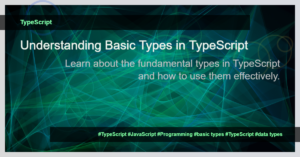Demystifying Template Literal Types in TypeScript
Have you ever wanted to create highly expressive and accurate type expressions in TypeScript? Have you ever wished for a way to generate complex code based on dynamic values? If so, then let me introduce you to the power of Template Literal Types.
What are Template Literal Types?
Template Literal Types are a powerful feature introduced in TypeScript 4.1. They allow you to create string literal types that can be formed by concatenating other string literal types or by manipulating other types using template expressions.
Imagine you have a function that receives a color as a parameter and returns a corresponding CSS class. Previously, you would have to rely on union types, but with Template Literal Types, you can create a much more expressive type:
type ColorClass<T extends string> = `text-${T}`;
const getColorClass = (color: Color): ColorClass<Color> => `text-${color}`;
const redClass: ColorClass<'red'> = getColorClass('red');
Here, ColorClass is a generic type that takes a string literal type T and produces a new string literal type by prefixing it with 'text-'. This allows you to enforce type safety and catch any invalid color values at compile-time.
Generating Code with Template Literal Types
One of the powerful use cases of Template Literal Types is code generation. You can use them to dynamically create code based on input values.
Let’s say you have a function that generates a CSS gradient based on an array of color stops:
type Color = string;
type Gradient = `linear-gradient(${number}%${' ' | ''}${number}%${' ' | ''}${Color})`;
const createGradient = (colors: Color[]): Gradient => {
const stopPercent = 100 / colors.length;
const stops = colors.map((color, index) => `${index * stopPercent}% ${color}`).join(', ');
return `linear-gradient(${stops})`;
};
const colors = ['red', 'blue', 'green'];
const gradient: Gradient = createGradient(colors);
Here, Gradient is a new type that represents a gradient CSS value formed by concatenating the percentage stops and colors using template expressions. This allows you to generate complex CSS code with strongly typed checks and avoid syntax errors.
Advanced Use Cases with Template Literal Types
Template Literal Types can be combined with other advanced TypeScript features to create even more powerful type expressions. Here are a few examples:
Mapping Union Types: You can use Template Literal Types to map over a union of string literal types and transform them into another type. This can be useful for creating sophisticated validators or mapping functions.
Generics with Constraints: Template Literal Types can be combined with generics to create constraints on the accepted values or to generate a derived type based on the input.
Conditional Types: You can leverage Template Literal Types in conditional types to specify different behavior based on the value of a template literal.
Conclusion
Template Literal Types are a game-changer in TypeScript when it comes to creating expressive and accurate type expressions. They enable robust type checking, code generation, and advanced type manipulation techniques. By mastering Template Literal Types, you unlock a new level of type safety and code automation in your TypeScript projects.
So, start exploring the possibilities and unleash the full potential of Template Literal Types in TypeScript!

















